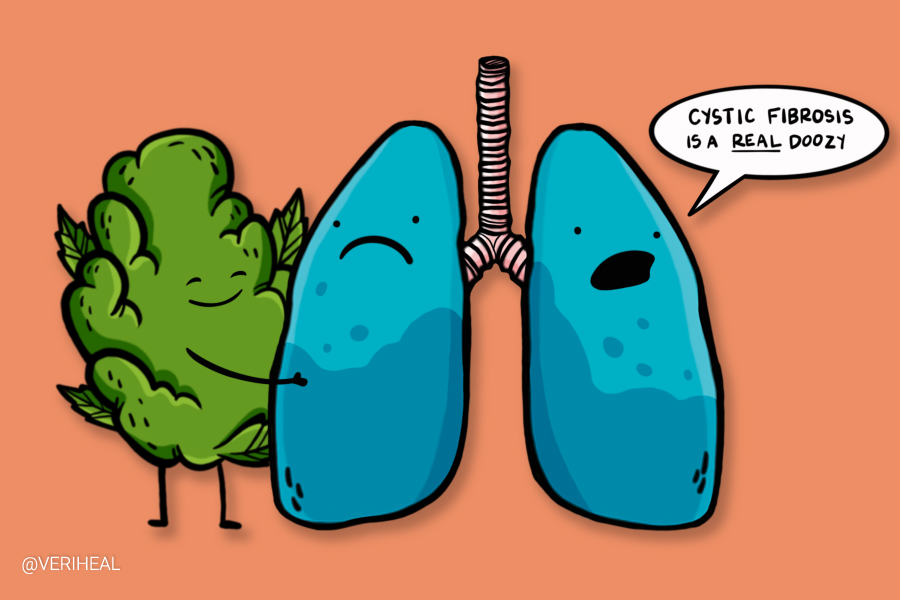Many of us will never know what it’s like to live with a life-threatening disease, let alone one that doesn’t have a cure. Those individuals who would know can teach us all a little something about strength and courage to continue facing life despite the looming possibility of death. While many individuals who suffer from Cystic Fibrosis, or CF, are able to live normal lives, many die from respiratory failure as a result of the disease. When looking at CF sixty years ago, you’ll find that a significant amount of children with the disease passed away before reaching elementary school age. However, modern medicine has been able to afford CF patients with longer live-spans, yet still shorter than normal. As the world looks into more of the conditions that cannabis can help, Cystic Fibrosis made the list.
Understanding Cystic Fibrosis
Cystic Fibrosis is explained as an inherited disease that can cause severe damage to vital organs such as the lungs, the digestive system (particularly the pancreas). Normally, people produce mucus, sweat, and digestive juices which are usually thin and slippery to act as lubricants. However, in the individual who inherited Cystic Fibrosis, those lubricants become thick and sticky which leads to clogged up tubes, ducts, and passageways, particularly in the lungs and pancreas. This disease can thus be life-threatening and individuals suffering from it, usually have shorter life-spans than those without cystic fibrosis. Respiratory failure is also the most common cause of death amongst those who are suffering from cystic fibrosis. While there is no cure for CF, individuals can take measures to improve their situation such as taking on and maintaining a good nutritious diet.
All newborns in America are screened for CF and may successfully present with CF when both parents have the defective gene. CF causes the body to produce thicker and stickier mucus and fluids that accumulate. This makes it more difficult to cough out which leads to complications in the lungs as well as interfering with the pancreatic function by preventing enzymes to properly break down foods, leading to digestive complications and potentially malnutrition. CF can also lead to the infertility of males since it may clog up the tubes which transport sperm.
CF is caused by a mutation in a gene known as the Cystic Fibrosis transmembrane conductance regulator (CFTR), which changes a protein that regulates the movement of salt in and out of cells. As stated above, one needs to have a copy of this mutated gene from each parent in order to present with CF. If the individual only inherited one parent’s CF gene, they will only become a carrier.
Symptoms of Cystic Fibrosis
Fortunately, the newborn screening for CF allows for early detection before symptoms become present, resulting in faster action to manage the condition and hopefully improve the quality of life. As with most other diseases, the symptoms will be presented and experienced differently and is largely dependent on the severity of CF. Some individuals who have CF, may not have symptoms until they are much older, while other lives have been claimed by CF before they’ve reached their teenage and young adult years.
Respiratory Signs and Symptoms
- Persistent coughing which produces thick mucus.
- Wheezing.
- Intolerance to exercise.
- Repetitive lung infections such as recurring pneumonia.
- Inflamed nasal passages.
- Stuffy nose.
- Recurrent sinusitis.
Digestive Signs and Symptoms
- Pancreatitis (recurring bouts of the inflamed pancreas)
- Foul-smelling, greasy stools.
- Poor weight gain.
- Poor growth.
- Intestinal blockage.
- Chronic or severe constipation.
- Rectal prolapse (part of the rectum protruding outside the anus).
Other Symptoms:
Cystic Fibrosis can lead to an array of complications such as damaged airways, chronic infections, growths in the nasal passage, coughing up blood, respiratory failure, diabetes, liver disease, intestinal obstruction, and thinning of bones along with mental health problems.
Why You Should Get Your Medical Marijuana Card
Veriheal has satisfied millions of patients nationwide by giving them access to these benefits
- Larger purchase limits
- Peace of mind
- Enhanced legal protection
- Access to higher potency strains
- Save up to 25% on cannabis purchases
- Skip the line at the dispensary
What Does Standard Treatment Look Like?
Since there is no cure for CF, treatment options only serve to alleviate symptoms, reduce the risk of complications as well as improve the quality of life. CF requires frequent checkups with doctors which may become costly. The goals of treatment include preventing and controlling infections, removing and loosening mucus, treating and preventing intestinal blockage as well as providing and ensuring good nutrition. The current treatments of CF involve pharmaceutical medications such as drugs that target the CF genes, airway clearance techniques such as vest therapy, pulmonary rehabilitation as well as surgical and other procedures including sinus surgery and oxygen therapy.
Can Cannabis Be Used to Manage Cystic Fibrosis?
Unfortunately, cannabis can not cure the disease, but it can offer up some relief from symptoms and while it may help significantly, it may not entirely get rid of the symptoms. As with all other diseases and conditions, cannabis is able to offer effective medical assistance due to its ability to interact with the body’s’ endocannabinoid system, or the ECS. The ECS has receptors located all over the body and is responsible for a host of functions, such as regulating inflammation.
Let’s have a look at what the different cannabinoids can offer CF patients as well as which strains would be best. The research available on cannabis for CF is few but cannabis is treating the symptoms, for which there is plenty of research.
Cannabinoids:
- Tetrahydrocannabinol (THC) stimulates the appetite by, in short, starting a ghrelin hormone surge, activating neurons to make you think you are hungry, and boosting our sense of smell, which all contribute to increased appetite. This would assist with weight loss and loss of appetite.
- Cannabidiol (CBD) has already earned a reputation for its medical prowess and can reduce nausea and vomiting (assisting with weight loss), alleviating experienced pain as well as reducing inflammation in the lungs due to its anti-inflammatory effect on the body. CBD can also assist with a sour stomach.
Although cannabis can help with the increase in appetite, it will not assist with the uptake in nutrients, but it does better the chances since patients will be eating more.
CF patients should consider cannabis that contains all cannabis compounds because of what is known as the “entourage effect”. In short, the entourage effect accounts for the synergy between the cannabis compounds and describes how cannabis can offer increased benefits when the cannabinoids are presented together, as opposed to isolated.
Recommended Strains:
The following strains are recommended based on THC/CBD quantity.
- Higher THC/Lower CBD
- Godfather OG
- Green Gelato
- OG Kush
- Lower THC/Higher CBD
- Harlequin
- Charlotte’s Web
- ACDC
- Balanced THC/CBD
- Sweet and Sour Widow
- Pennywise
- Dancehall
CF patients should consult with medical physicians knowledge in cannabis in order to establish strains would work best for the symptoms and for the wanted effects. Be sure to check out Veriheal’s personal consult service that helps patients target the right cannabinoids and terpenes. Alternatively, one can experiment for themselves by trying small amounts of different strains until finding the strain and quantity combination which best works for you.
Author, Share & Comments
















